Product Description
Product Description
Sheave features:
| Material | Q235B, Q345B, 35#, 45#, 60#, SSW-QR1, S45C |
| Groove surface quench | HRC45-55 |
| Groove surface quench depth | 2mm-2.5mm |
| groove MT after heat treatment and welding line UT and MT | |
| Max processing diameter | 2, 000mm |
| Short production cycle | |
| It is used for crane equipment, port equipment, oil drilling rig and so on | |
Product Parameters
| Code | Wire rope diameter(mm) | Main dimension(mm) | |||||
| Groove diameter | Outside diameter | R | Groove Width | Shaft diameter | Bearing hole width | ||
| BX1251 | 10-14 | 355 | 400 | 7 | 37 | 55 | 64 |
| BX2251 | >14-19 | 450 | 510 | 10 | 50 | 80 | 74 |
| BX3251 | >19-23.5 | 560 | 631 | 12 | 60 | 95 | 90 |
| BX4251 | >23.5-30 | 710 | 800 | 15 | 73 | 130 | 106 |
| BX5251 | >23.5-30 | 900 | 1012 | 19 | 92 | 160 | 128 |
| BX6251 | >30-37 | 1000 | 1126 | 22 | 104 | 160 | 128 |
| BX7251 | >43-50 | 1250 | 1402 | 26 | 123 | 190 | 148 |
| BX8251 | >50-58 | 1400 | 1572 | 29 | 135 | 190 | 148 |
Production Profile
About Us
About Us
As a company of industries and trading integration with ISO 9001-2008 Certificate, HangZhou CHINAMFG Metallurgy Equipment Manufacturing Co., Ltd. Has been in manufacturing material handling equipment parts for many years, with professional experience.
Our Service:
If you are interested in any of our products, please contact me freely! Warmly Welcomed your visit to our factory in China, OEM service will be ok.
Application
Customer Visiting
Certifications
Packaging & Shipping
Services:
Best Services For You
1) We can provide OEM service and design for you
2) We can pack the goods according to your requirement
3) We test the quality of all products before delivery
4) We guarantee our reply in 24 hours of working day
5) We can communicate with you in different languages
6) High quality, best price, punctual shipment, good after-sale service will be guaranteed.
FAQ:
Q: What information should I provide if I want to order the products?
1) Product information: Quantity, specification
2) Delivery time required.
3) Shipping information: Company name, address, phone number, destination seaport/air port.
4) Forwarder's contact details if there is any in China.
Q: How about your payment terms?
A: 30% -50%deposit, with the balance before delivery, we accept T/T and L/C at sight.
Q: Can I use our own logo?
A: Yes, we can produce by using your own logo if you need.
Q: How about sample & MOQ policy?
A: Welcome sample order. MOQ can be 1 set.
Q: What is your lead time for your goods?
A: Normally 30 days after confirmed order,
/* January 22, 2571 19:08:37 */!function(){function s(e,r){var a,o={};try{e&&e.split(",").forEach(function(e,t){e&&(a=e.match(/(.*?):(.*)$/))&&1
| Type: | Construction Winch |
|---|---|
| Driven Type: | Screw |
| Speed: | Slow |
| Carrying Capacity: | Weight Level |
| Tonnage: | 30T |
| Reel Number: | 1 |
| Customization: |
Available
| Customized Request |
|---|

How do winch pulleys contribute to the functioning of recreational and ATV winches?
Winch pulleys play a crucial role in the functioning of recreational and ATV (All-Terrain Vehicle) winches. Here is a detailed explanation:
Recreational and ATV winches are widely used for various outdoor activities, such as off-roading, recovery operations, and recreational vehicle applications. Winch pulleys are an essential component of these winches and contribute to their functionality in several ways:
- Mechanical Advantage: Winch pulleys provide a mechanical advantage in the operation of recreational and ATV winches. By incorporating pulleys into the system, the pulling force generated by the winch motor can be multiplied. The pulley system allows the winch to exert greater force than the input force applied by the motor. This mechanical advantage enables the winch to handle heavier loads and overcome resistance more effectively, making it possible to recover stuck or immobilized vehicles and tackle challenging terrain.
- Directional Change: Winch pulleys enable directional change in the pulling or lifting operation. By rerouting the cable or rope through the pulleys, the winch can change the angle of pull and alter the direction of force application. This feature is particularly useful in off-road or recovery scenarios where the winch needs to pull the vehicle from different angles or positions. The pulley system allows for versatile positioning and effective utilization of the winch in various situations.
- Increased Cable Length: Winch pulleys contribute to extending the effective cable length of recreational and ATV winches. By incorporating pulleys, the cable or rope can be routed back and forth between the drum and the anchor point. This arrangement effectively increases the distance the cable can travel, allowing the winch to reach objects or vehicles at greater distances. The extended cable length provided by winch pulleys enhances the versatility and reach of the winching operation, enabling users to access difficult-to-reach areas or perform rescues in diverse scenarios.
- Load Distribution: Winch pulleys help distribute the load evenly across the winching system. When the cable or rope is routed through the pulleys, the load is shared among multiple lines or strands. This load distribution prevents excessive stress on any single component, such as the cable, rope, or winch drum. By spreading the load, winch pulleys help minimize the risk of overload or failure, ensuring the safe and efficient operation of recreational and ATV winches.
- Overcoming Obstacles: Winch pulleys assist in overcoming obstacles during winching operations. In off-road or recovery scenarios, there may be obstacles, such as trees, rocks, or other vehicles, that obstruct the direct path between the winch and the anchor point. Winch pulleys enable the cable or rope to be redirected around these obstacles, allowing the winch to exert force from a different angle or position. This adaptability provided by winch pulleys helps navigate challenging terrains and overcome obstacles, increasing the success rate of recovery operations.
- Controlled Speed: Winch pulleys contribute to controlling the speed of the winching operation. By adjusting the position or configuration of the pulleys, operators can regulate the speed at which the cable or rope is pulled in or let out. This speed control feature is valuable in situations where precision and fine adjustments are required, such as when aligning or positioning objects, or when performing delicate maneuvers. Winch pulleys allow for controlled and gradual movements, enhancing the operator's ability to handle recreational and ATV winches with accuracy and safety.
In summary, winch pulleys are essential for the functioning of recreational and ATV winches. They provide a mechanical advantage, enable directional change, increase cable length, distribute the load, help overcome obstacles, and allow for controlled speed. These contributions make winch pulleys versatile tools, facilitating successful off-roading, recovery operations, and recreational vehicle applications, while ensuring safety, efficiency, and enhanced capabilities for users.

Can winch pulleys be customized for various winching systems?
Yes, winch pulleys can be customized to suit various winching systems. Here is a detailed explanation:
Winch pulleys are versatile components that can be adapted and customized to meet the specific requirements of different winching systems. Customization allows for the optimization of pulley size, design, and features to enhance the performance and compatibility with the winch system. Here are some aspects of winch pulleys that can be customized:
Load Capacity: Winch pulleys can be customized to match the load capacity of the winching system. This involves selecting or manufacturing pulleys with load ratings that align with the maximum load that the winch is designed to handle. Customization ensures that the pulley can handle the anticipated loads without compromising safety or performance.
Sheave Diameter: The sheave diameter of winch pulleys can be customized to suit the specific requirements of the winching system. By selecting a suitable sheave diameter, the mechanical advantage and line speed can be optimized for the intended application. Customizing the sheave diameter allows for fine-tuning the winching system's performance to achieve the desired balance between pulling power and speed.
Material and Construction: The material and construction of winch pulleys can be customized to meet the environmental conditions and demands of the winching system. Different materials, such as steel, stainless steel, or high-strength polymers, can be chosen based on factors like corrosion resistance, durability, and weight considerations. Customization may also involve selecting the appropriate bearing type, lubrication, and overall construction to ensure longevity and reliable operation.
Attachment Options: Winch pulleys can be customized with various attachment options to facilitate easy integration into different winching systems. This includes options for different mounting configurations, such as fixed or swivel hooks, brackets, or eyelets, to accommodate the specific connections and rigging arrangements of the winch system. Customization allows for seamless integration and compatibility.
Special Features: Depending on the specific requirements of the winching system, winch pulleys can be customized with special features. This may include self-cleaning grooves, high-visibility colors, or additional safety enhancements like locking mechanisms or protective guards. Customization enables the incorporation of features that enhance the functionality, safety, and ease of use of the winching system.
Compatibility: Customizing winch pulleys ensures compatibility with the specific winch model or brand. This involves considering the dimensions, specifications, and recommendations provided by the winch manufacturer. Customized pulleys can be designed to fit seamlessly with the winch system, ensuring optimal performance and reducing the risk of compatibility issues.
Overall, winch pulleys can be customized to meet the specific requirements of various winching systems. Customization allows for the selection of pulley load capacity, sheave diameter, material, construction, attachment options, and special features to optimize performance, compatibility, and safety.

What types of cables or ropes are typically used with winch pulleys?
Winch pulleys are designed to accommodate various types of cables or ropes depending on the specific application and requirements. Here is a detailed explanation of the types of cables or ropes that are typically used with winch pulleys:
- Steel Cable: Steel cables, also known as wire ropes, are commonly used with winch pulleys. They are highly durable, have high tensile strength, and offer excellent resistance to abrasion and cutting. Steel cables are suitable for heavy-duty applications where strong pulling forces and load-bearing capacity are required. They are commonly employed in industries such as construction, mining, and off-road recovery.
- Synthetic Rope: Synthetic ropes made from materials such as high-strength polyethylene (HMPE), nylon, or polyester are becoming increasingly popular in winching applications. Synthetic ropes offer several advantages over steel cables, including lighter weight, flexibility, and easier handling. They are also safer in the event of a rope failure, as they do not store as much energy as steel cables. Synthetic ropes are commonly used in off-road recovery, recreational winching, and marine applications.
- Fiber Rope: Natural fiber ropes, such as manila or sisal, were historically used with winch pulleys but have been largely replaced by steel cables and synthetic ropes in industrial applications. However, fiber ropes are still employed in certain specialized applications or industries where their specific properties are beneficial. For example, they may be used in situations where low conductivity or reduced risk of sparking is important.
- Wire Rope Sling: In some cases, wire rope slings may be used with winch pulleys. Wire rope slings consist of multiple strands of wire rope formed into a loop or sling configuration. They are commonly used for lifting and rigging applications where a flexible and strong sling is required to connect the load to the winch pulley. Wire rope slings offer excellent load-bearing capacity and flexibility.
The selection of the appropriate cable or rope for a winch pulley depends on various factors such as the intended application, load requirements, environmental conditions, and safety considerations. It is important to consider the specific requirements and consult the manufacturer's recommendations to ensure the compatibility and safe use of the cable or rope with the winch pulley.


editor by CX
2024-03-15